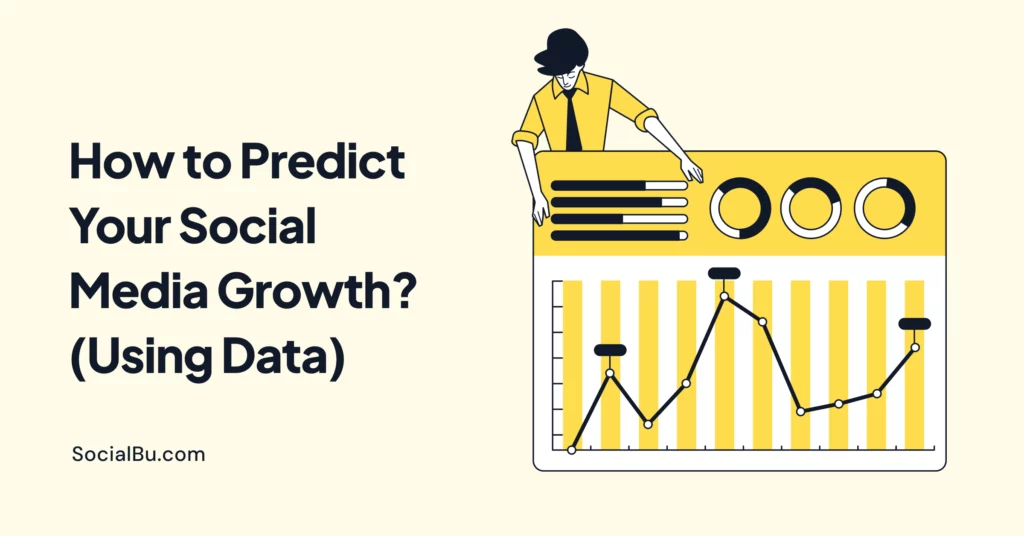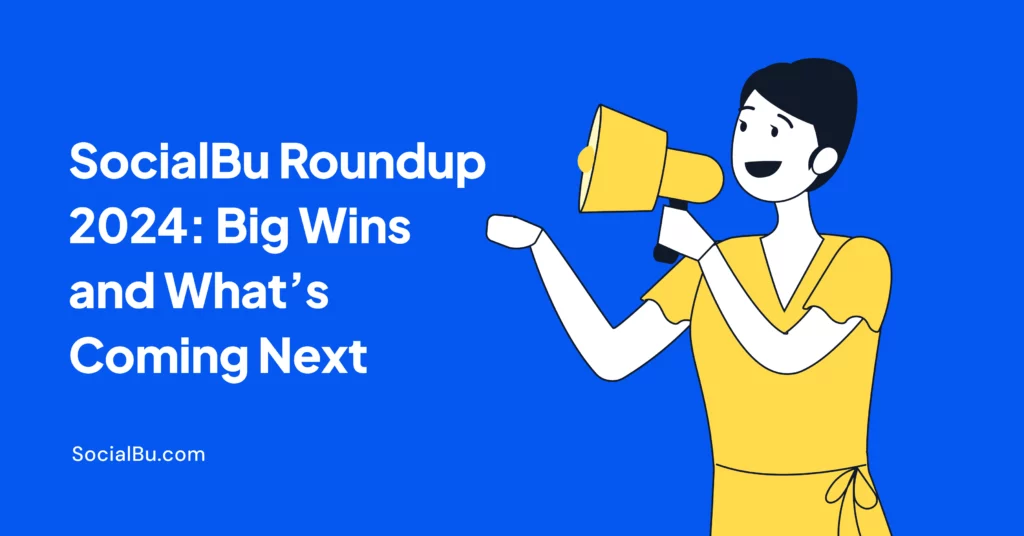If your social media growth relies on guesses or “what worked last month,” then you’re missing out on the absolute data-backed predictability.
We know you have been in this game of running campaigns for clients, scaling a startup’s online presence, or managing content for a global brand. The good news? You don’t need to be a data scientist. You only need the right metrics, tools, and a simple way to read the signals your data is already giving you.
In this guide, we’ll break down how to:
- Track and analyze the right social media metrics
- Use past performance to forecast future results
- Apply predictive analytics for a more innovative strategy
- Choose tools that simplify all of the above
So, keep reading, and let’s turn your data into a clear direction!
What are Social Media Growth Metrics?
Before you can predict growth, you must understand what growth looks like. Social media success is more than vanity metrics, such as likes or views. It is essential to know which metrics indicate growth and how they relate to your broader business goals.
Here are the key social media growth metrics to monitor:
Engagement Rate
This tells you how well your content resonates. It includes likes, shares, comments, saves, and replies. A consistently high engagement rate indicates healthy audience interaction and predicts future content performance.
Reach and Impressions
- Reach = unique users who saw your content
- Impressions = total number of times your content was displayed
Tracking these over time helps you spot content types or formats that expand your visibility. It’s a critical metric to track social media growth over time.
Learn more about the Reach vs Impression!
Follower Trends
Predict your follower growth on social media.
Monitor and analyze:
- How your followers grow week by week
- Which content or campaigns drive that growth
This becomes even more valuable when combined with content performance data.
Conversion Tracking
Likes are great, but do they lead to results? Conversion metrics track link clicks, sign-ups, sales, or any action tied to business goals. This is how you calculate social media ROI with data, not just by looking at it.
Content Performance KPIs
Use your platform’s analytics dashboard and evaluate what formats are outperforming.
- Are Reels getting 3x more reach than image posts?
- Is Story interaction higher than Feed engagement?
These insights help you forecast social media engagement.
So, constantly monitoring your social media growth metrics gives you a clear view of the next 30, 60, or 90 days.
Steps to Predict Social Media Growth Using Data
Now that you understand which metrics matter, let’s talk about how to use data to grow on social media — and more importantly, predict future growth confidently.
Here’s a four-step data-driven approach to help you track social media growth over time and forecast your next big wins.
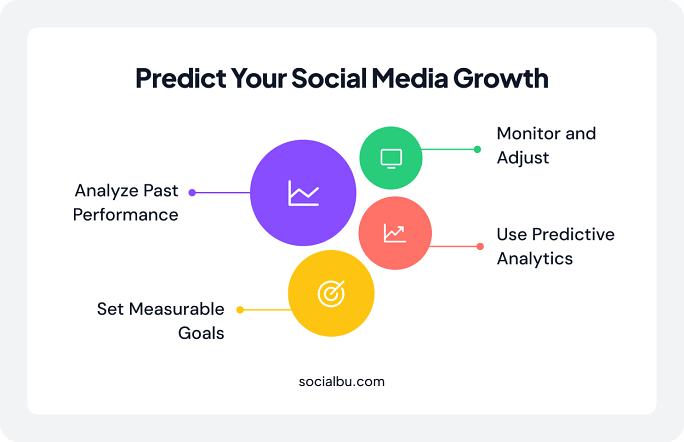
1. Analyze Past Performance
Your past content is a goldmine of insights. Start by analyzing your historical data to identify what’s working and what’s not.
- Look at engagement rate, reach, and conversions over the last 3–6 months.
- Break it down by content type: Did videos outperform static posts? Did Stories drive more replies than Feed posts?
You can use SocialBu to visualize patterns in content performance and identify social media performance trends.
For instance, if your Instagram carousels consistently drive higher engagement, that’s a signal to scale that format.
This is where you begin to analyze social media data for future growth.
2. Set Measurable Growth Goals
Without clear goals, your predictions have no direction. Set targets based on growth KPIs such as:
- Follower growth (e.g., +12% in 90 days)
- Engagement rate (e.g., increase by 15%)
- Conversion rates (e.g., boost link clicks from Stories by 20%)
For Example:
- As a startup brand, you can aim to grow LinkedIn followers by 1,000 within a quarter.
- As a social media manager, you can focus on improving story views to increase product page visits.
Setting data-backed goals helps you evaluate content performance to forecast growth more accurately.
3. Use Predictive Analytics Tools
This is where the real forecasting of your social media growth starts. Predictive analytics for social media uses historical data, machine learning, and behavioral trends to estimate what’s next.
Use predictive modeling to:
- Forecast follower count by platform
- Predict post-level engagement
- Recommend optimal posting times based on historical trends
For example, if your TikToks usually gain traction after 1,000 views, a predictive model can tell you when the next one might hit 10,000.
This helps you build a social media growth forecast rooted in data and not guesswork.
4. Monitor and Adjust in Real Time
We all know social media isn’t static, and so neither should your strategy be.
As campaigns go live, use real-time analytics dashboards to monitor what’s performing.
Key tactics:
- Adjust your posting time if engagement drops
- Switch content types if one format underperforms
- Track competitor content with social listening or benchmarking tools
If your TikTok posts underperform, the problem may not be just the content but timing or frequency. Use this insight to iterate. This step is essential for tracking growth for social media campaigns and keeping your brand growth projections accurate.
Read SocialBu’s detailed study about the Best Time to Post on TikTok!
How to Use Historical Data to Forecast Future Growth
If you’re wondering how to measure social media growth, move beyond monthly reporting, and predict social media growth, this section is for you.
Your historical social media data holds powerful clues about what’s ahead. Analyzing past patterns allows you to create reliable social media growth forecasts and build smarter strategies.
Let’s break it down.
1. Identify Long-Term Performance Patterns
Analyze your social media analytics dashboard from the past 6–12 months.
Look for trends in:
- Follower growth over time
- Average engagement per content type (Reels, Stories, static posts)
- Best-performing days and times to post
- Campaigns that drove spikes in reach or conversions
Plot these metrics on a monthly timeline to spot social media performance trends and get the answers to;
- Did your engagement dip during a product launch?
- Did Reels boost your visibility in Q1?
This step helps you analyze social media data for future growth and understand your momentum.
2. Compare Platform-Specific Metrics
Each social media platform has a different pattern. Your TikTok content might explode overnight, while LinkedIn content may grow steadily over time.
Break your data down by platform to get a channel-specific growth picture:
Platform | Growth Metric to Watch | Why It Matters |
Follower Growth & Engagement Rate | Indicates brand awareness & content effectiveness | |
TikTok | Video Views & Shares | Predicts virality and future reach |
Impressions & Clicks | Reflects professional visibility & traffic potential | |
Page Likes & Reach | Shows community growth and brand recall |
This helps you track social media growth over time by platform, a must for multi-channel brands.
3. Spot Seasonal Trends and Campaign Impact
Your past data will reveal seasonal content patterns that can guide your forecast:
- Did engagement spike during Black Friday or Cyber Monday campaigns?
- Was there a drop in December when your audience was less active?
Use these insights to create a data-driven content calendar and align future campaigns with proven high-performing windows.
This helps you to get real data and patterns and guides your next strategy.
4. Create Campaign Benchmarks to Predict Future Metrics
Once you know your average monthly growth rate, you can start forecasting.
For example:
If your Instagram following grew by 8% per month for the last 6 months, you can reasonably expect similar growth — unless you change your strategy.
Use tools like Google Sheets or SocialBu to calculate:
- Projected follower count
- Anticipated engagement rate
- Expected website visits from social
This is key in building an actionable social media growth forecast for your next quarter.
5. Build a Visual Growth Forecast Dashboard
Presenting your projections visually helps clients and internal teams understand the potential impact.
Use line graphs, growth curves, and KPI charts to map out:
- Where your current performance stands
- Where you’re headed (based on past trends)
- What actions are needed to hit your targets
This ties your growth tracking for social media campaigns directly to strategic planning.
Bonus Tip: Use your forecasts to back up budget and resourcing requests. Data-driven projections give you a stronger case when asking for ad spend, new tools, or more team support
SocialBu helps you analyze social media data for future growth by showing which posts perform best and why.
Best Tools for Social Media Growth Prediction
Once you’ve gathered your historical data, the right tools can help turn it into reliable growth forecasts. From automated dashboards to future social media performance, here are the top tools to help you track social media growth over time and plan confidently.
1. SocialBu – Smart Social Media Automation with Growth Insights
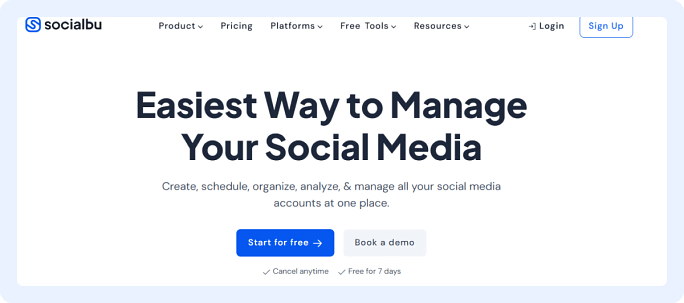
SocialBu is a powerful all-in-one social media management tool designed specifically to help you track performance, predict growth, and automate tasks across multiple platforms. Its Analyze feature is where the real forecasting magic happens. This SocialBu feature lets you get comprehensive social media reports through easy charts and graphs to make better decisions and improve your content strategy.
Here you can track and identify:
- Top performing posts
- Engagement trends
- Individual post insights
- Account’s growth trends
- Follower changes
- Platform-specific performance
All of this in a visual, digestible format.
The clean UI and customizable analytics make it easy to identify patterns and set future goals even if you’re not a data analyst.
If you manage multiple accounts and want deep insights without being overwhelmed, SocialBu is a great pick, especially for marketers and agencies focused on long-term results.
What Makes SocialBu Stand Out:
- Automated reports that show follower growth, engagement trends, and reach over time
- Custom dashboards for visualizing performance metrics clearly
- Post scheduling + performance tracking in one platform
- Forecasting insights based on past post metrics, growth rate, and engagement behavior
- Multi-platform support and growth tracking (Instagram, Facebook, X, LinkedIn)
- AI-based growth insights and content suggestions
- A user-friendly and affordable way to track social media growth over time
- Team collaboration and client approval workflows
Pricing:
- Offers a 7-day free trial.
- Standard plan: Starts at $19/month.
- Super: Start at $59/month (Billed monthly).
- Supreme: $ 199/month (Billed monthly).
2. Hootsuite – Full-Scale Social Media Management
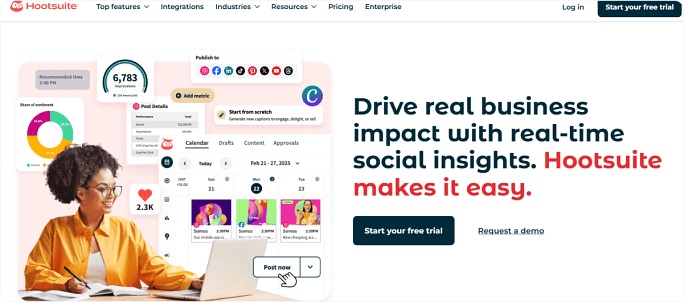
Hootsuite is one of the oldest platforms in the game. While it’s known for scheduling and monitoring, its analytics and trend reports can also help you understand what’s working and plan future growth accordingly.
It offers platform-specific insights and custom reports, making it useful for large teams handling multiple brands.
Key Features:
- Visual analytics dashboards
- Cross-platform reporting
- Content calendar planning
- ROI tracking from social ads
- Customizable performance reports
Pricing:
- Starts at $149 per user/month (monthly) with a 30-day free trial.
3. Sprout Social – Enterprise-Level Reporting and Predictions
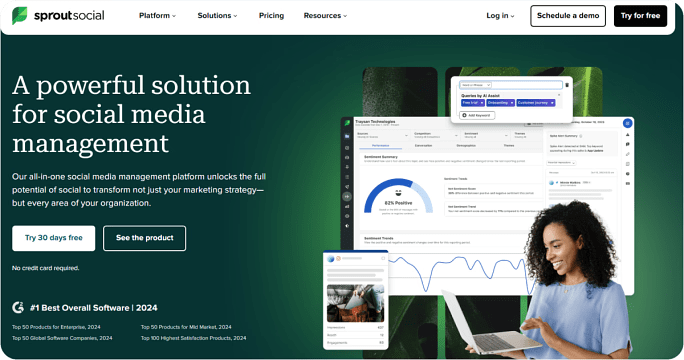
Sprout Social is ideal for brands that need in-depth analytics and intelligent forecasting. It offers tools to measure KPIs, benchmark against competitors, and predict future growth based on historical performance.
Its presentation-ready reports make it great for teams needing to share results with stakeholders or clients.
Key Features:
- Smart trend analysis
- Competitive benchmarking
- Custom reporting builder
- Campaign-level analytics
- Sentiment analysis and audience insights
Pricing:
- Starts at $199 per seat/month with a 30-day free trial.
4. Buffer – Simple Yet Insightful Analytics
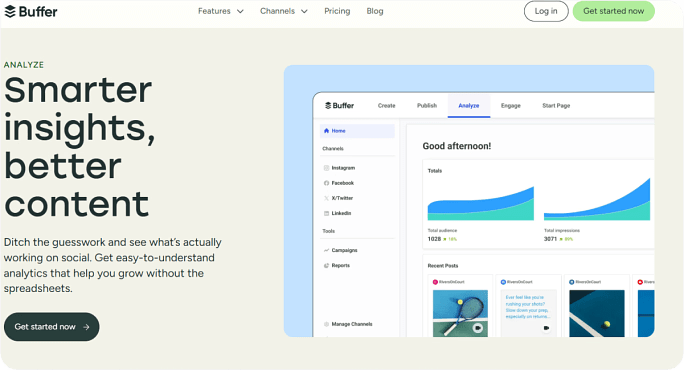
This tool focuses on clean performance data. With a user-friendly dashboard, it’s especially useful for small teams or creators who want to track social media growth over time. Moreover, it does a great job with historical comparisons and trend spotting.
Key Features:
- Easy-to-read engagement and reach reports
- Follower growth tracking over time
- Post-performance comparisons
- Exportable graphs and charts
- Instagram Stories and post insights
Pricing:
- A free plan that supports up to 3 channels is available.
- Starts at $6/month per channel (Billed monthly).
5. Iconosquare – Analytics for Instagram and TikTok Pros
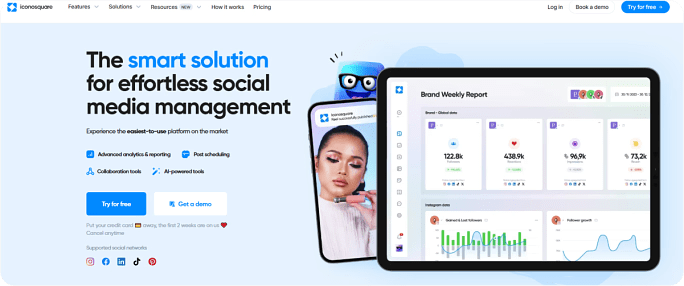
Iconosquare specializes in providing detailed analytics for visual platforms like Instagram and TikTok. It helps marketers monitor performance trends, content reach, and forecast audience growth based on historical benchmarks.
The platform is particularly popular with agencies managing influencers or e-commerce brands.
Key Features:
- In-depth analytics for Instagram, TikTok, Facebook, and LinkedIn
- Custom dashboards and growth reports
- Competitor tracking
- Scheduling and media library
- Influencer performance monitoring
- AI content inspiration
Pricing:
- Starts at $39/month (billed monthly) with a free trial.
Common Mistakes to Avoid While Forecasting Social Media Growth
Forecasting your social media growth can guide smarter content and budgeting decisions. However, it’s easy to fall into traps leading to overestimations, missed targets, or misguided strategies.
Here are some of the most common mistakes and how to avoid them:
1. Relying Only on Vanity Metrics
Focusing solely on follower counts or likes can give you an unbalanced picture. These numbers may look good, but they don’t always translate to actual engagement or conversions.
What to do instead: Track engagement rates, click-throughs, and conversion metrics to get a more meaningful view of growth.
2. Not Considering Platform Algorithm Changes
Social media platforms frequently update their algorithms, drastically affecting post visibility and performance.
You must stay current with platform changes and consider them in your forecasting models. Tools like SocialBu reflect such changes through real-time analytics.
3. Ignoring Seasonal or Campaign-Based Spikes
Some social media data lead to unrealistic expectations, such as using peak campaign data (like during a product launch or Black Friday) to forecast regular growth.
What to do instead: Separate outliers from organic trends. Use averages from consistent performance periods instead of peak metrics.
4. Lack of Historical Data Range
Short-term trends can also be misleading, and using too little data (like one month or a single campaign) can lead to flawed forecasts.
The Solution: Analyze at least 3 to 6 months of consistent historical data to identify meaningful patterns.
5. Assuming Linear Growth
Social media growth is rarely a straight upward line. Engagement plateaus, algorithm hits, or content fatigue can all cause dips.
What to do instead: Build room for plateaus and drops in your predictions. Use trend lines and moving averages instead of assuming constant growth.
6. Not Segmenting by Platform
Each platform has its own growth dynamics. Instagram might grow faster than X (Twitter), and what works on LinkedIn might flop on Facebook.
The solution is to forecast growth per platform separately and adjust content strategies accordingly.
7. Ignoring Audience Behavior Shifts
If your audience changes in size, interest, or demographics, your previous performance might not predict future results.
What you can do instead is to regularly reassess your audience insights (tools like Buffer Analyze and Iconosquare help here) and adjust forecasts based on updated behavior data.
Now, you have all the pitfalls that can mislead your social media growth forecasting. So, avoid these pitfalls to ensure your forecasting strategy remains grounded, realistic, and actionable.
Final Takeaway
So now you know forecasting social media growth is more than throwing numbers into a spreadsheet or hoping your next post goes viral. It’s about making data work for you.
But how? It’s by identifying patterns, analyzing performance, and planning for scalable results.
With the right tools like SocialBu and the right approach to interpreting historical data, you can confidently answer questions like:
- How fast are we growing?
- What’s working and what’s not?
- Where should we double down?
And remember, though the future is never 100% predictable, your strategy doesn’t have to be uncertain. Avoid common forecasting mistakes, stay agile, and adjust your plans as new data arrives.
So, are you ready to take control of your social media growth?
Start using data-backed insights to predict and accelerate your growth path. Whether you’re managing one account or a dozen, the right forecasting mindset turns guesswork into a growth strategy.
SocialBu is the best tool for your forecasting needs. Check out our detailed breakdown of the tool above and sign up for a 7-day free trial to get started.
FAQs
What is the 5 5 5 Rule on Social Media?
The 5-5-5 rule refers to building a social media presence and increasing engagement. This means liking five posts by others, commenting on five posts or sharing them, and curating five posts from industry sources.
How to Forecast Social Media Growth?
Analyze historical performance data—engagement rate, reach, follower trends, etc.- and use SocialBu as a predictive analytics tool. Set measurable KPIs and continuously track campaign performance to refine your predictions.
What is the 70/20/10 Rule in Social Media?
This rule in social media is known as the content strategy guideline that fuels organic social media growth.
Here’s the breakdown:
- 70% of your content should add value (Informational/Educational/Engaging)
- 20% should be curated from others (shared content)
- 10% promotional content
What is the 50 30 20 Rule for Social Media?
The 50/30/20 rule for social media is a content creation framework that suggests:
- 50% of your content should entertain or engage your audience,
- 30% should inform or educate,
- And 20% should promote your brand or products.
This balance helps maintain audience interest while driving conversions.
Which Metrics are Best for Tracking Social Media Growth Over Time?
Focus on follower growth, engagement rate, impressions, reach, and content performance. These KPIs help you monitor your social media growth metrics and estimate future social media performance accurately.
